 W
WBlack-red-green coalition, also known as the Kenya coalition and Afghanistan coalition is a term in German politics describing a governing coalition among the parties of the Christian Democratic Union/Christian Social Union (CDU/CSU), Social Democratic Party (SPD) and the Green Party. The name comes from the traditional colours of the parties, with the CDU represented by black, the SPD by red, and the Greens by green. As these are also the colours of the Kenyan and Afghan flags, the names of these countries are sometimes applied to the arrangement, in the same manner as the black-yellow-green "Jamaica coalition".
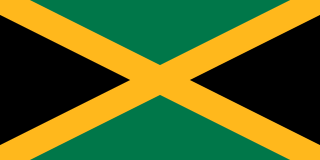 W
WJamaica coalition is a term in German politics describing a governing coalition among the parties of the Christian Democratic Union/Christian Social Union (CDU/CSU), Free Democratic Party (FDP), and the Green Party.
 W
WTraffic light coalition is a term originating in German politics where it describes a coalition government of the Social Democratic Party of Germany (SPD), the Free Democratic Party (FDP) and The Greens. It arises from the fact that the parties' traditional colours, respectively red, yellow and green, resemble the normal colour sequence of a traffic light (Ampel). It has subsequently been used to describe similar coalitions between social democrats, liberals and greens in other countries.
 W
WThe First Adenauer cabinet was the 1st Government of Federal Republic of Germany in office from 20 September 1949 until 20 October 1953. It was the first democratically-elected German cabinet after World War II. The cabinet was formed after the 1949 elections. Konrad Adenauer reached an agreement on a coalition with the Free Democratic Party (FDP), German Party (DP) and his Christian Democratic Union (CDU) together with their Bavarian sister party Christian Social Union (CSU), setting the stage for Adenauer to become the first Chancellor of Germany. Franz Blücher (FDP) served as Vice-Chancellor of Germany and Federal Minister of Matters of the Marshall Plan. The cabinet was succeeded by the Second Adenauer cabinet.
 W
WThe Second Adenauer cabinet led by Konrad Adenauer was sworn in on 20 October 1953 after the 1953 elections. It laid down its function after the formation of the Cabinet Adenauer III on 29 October 1957, which was formed following the 1957 elections.
 W
WThe Third Adenauer cabinet was formed by incumbent Chancellor Konrad Adenauer after the 1957 federal election. The cabinet was sworn in on 29 October 1957, and remained until it was succeeded by the fourth Adenauer cabinet on 17 October 1961.
 W
WThe Fourth Adenauer cabinet was formed by incumbent Chancellor Konrad Adenauer after the 1961 federal election. The cabinet was sworn in on 14 November 1961.
 W
WThe Bauer cabinet was the second democratically elected Reichsregierung of the German Reich. It was named after Reichsministerpräsident Gustav Bauer and took office on 21 June 1919 when it replaced the Cabinet Scheidemann. Although the Weimar Constitution was not in force yet, it is generally counted as the second government of the Weimar Republic.
 W
WThe First Brandt cabinet was the government of Germany between 22 October 1969 and 15 December 1972, during the 6th legislature of the Bundestag. Led by the Social Democrat Willy Brandt, the cabinet was a coalition between the Social Democrats (SPD) and the Free Democratic Party (FDP). The Vice-Chancellor was the Free Democrat Walter Scheel (FDP).
 W
WThe Second Brandt cabinet was the government of Germany between 15 December 1972 and 17 May 1974, during the 7th legislature of the Bundestag. Led by the Social Democrat Willy Brandt, the cabinet was a coalition between the Social Democrats (SDP) and the Free Democratic Party (FDP). It followed the Cabinet Brandt I. Following Brandt's resignation as Chancellor on 7 May 1974, Vice-Chancellor Walter Scheel (FDP) served as Acting Chancellor for nine days, until the inception of the Cabinet Schmidt I.
 W
WHeinrich Aloysius Maria Elisabeth Brüning was a German Centre Party politician and academic, who served as the chancellor of Germany during the Weimar Republic from 1930 to 1932.
 W
WHeinrich Aloysius Maria Elisabeth Brüning was a German Centre Party politician and academic, who served as the chancellor of Germany during the Weimar Republic from 1930 to 1932.
 W
WThe Council of the People's Deputies was the name given to the government of the November Revolution in Germany from November 1918 until February 1919. The Council de facto took over the function of head of state (Kaiser) and head of government (Chancellor), and issued decrees replacing the legislation of parliament (Reichstag) and Federal Council. The state secretaries stayed in office or were replaced by the Council.
 W
WThe First Erhard cabinet was the government of Germany between 17 October 1963 and 26 October 1965. Led by the Christian Democratic Union Ludwig Erhard, the cabinet was a coalition between the Christian Democratic Union (CDU) and the Free Democratic Party (FDP). The Vice-Chancellor was the Free Democrat Erich Mende (FDP).
 W
WThe Second Erhard cabinet was the government of Germany between 26 October 1965 and 30 November 1966. Led by the Christian Democratic Union Ludwig Erhard, the cabinet was a coalition between the Christian Democratic Union (CDU) and the Free Democratic Party (FDP).
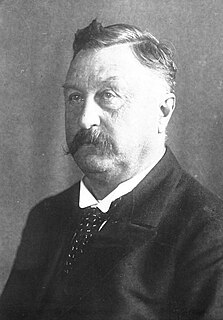 W
WThe Fehrenbach cabinet was the fourth democratically elected Reichsregierung of the German Reich. It was named after Reichskanzler (chancellor) Constantin Fehrenbach and took office on 25 June 1920 when it replaced the First Müller cabinet.
 W
WThe Kiesinger cabinet was the 8th Government of the Federal Republic of Germany from 1 December 1966 to 21 October 1969 throughout the 5th legislative session of the Bundestag. Led by Christian Democrat and former Nazi Party member Kurt Georg Kiesinger. The Bundestag chosen in the September 1965 election initially resulted in the Cabinet Erhard II, but when the FDP resigned from the government, that led to the formation of this new cabinet. The cabinet was supported by the first grand coalition between the Christian Democratic Union (CDU), Christian Social Union of Bavaria (CSU) and the Social Democratic Party (SPD). The Vice-Chancellor was the Social Democratic Party Willy Brandt (SPD)
 W
WThe First Kohl cabinet led by Helmut Kohl was sworn in on October 4, 1982 and was in office until March 29, 1983. The cabinet was the first to be formed after a constructive vote of no confidence. It was succeeded by the Second Kohl cabinet, which was formed after the 1983 elections. By means of a vote of confidence that Kohl initiated and lost, as well as the dissolution of the 9th German Bundestag by President Karl Carstens, the government ended with the meeting of the 10th German Bundestag in 1983. With a duration of just under half a year, the cabinet Kohl I was the shortest-lived German government since the cabinet von Schleicher in the Weimar Republic and is, as yet, the shortest-lived cabinet in the history of the Federal Republic.
 W
WThe Second Kohl cabinet led by Helmut Kohl was sworn in on March 29, 1983 and laid down its function on March 11, 1987. The cabinet was formed after the 1983 elections. It was succeeded by the Cabinet Kohl III, which was formed following the 1987 elections.
 W
WThe Third Kohl cabinet led by Helmut Kohl was sworn in on March 12, 1987. The cabinet was formed after the 1987 elections. This cabinet oversaw the German Reunification. It laid down its function on January 18, 1991, after the formation of the Fourth Kohl cabinet, which was formed following the 1990 elections.
 W
WThe Fourth Kohl cabinet led by Helmut Kohl was sworn in on 18 January 1991 and laid down its function on 15 November 1994. The cabinet was formed after the 1990 elections. It laid down its function after the formation of the Cabinet Kohl V, which was formed following the 1994 elections.
 W
WThe First Luther cabinet was the 12th democratically elected Reichsregierung of the German Reich, during the period in which it is now usually referred to as the Weimar Republic. The cabinet was named after Reichskanzler (chancellor) Hans Luther and was in office for only a year. On 15 January 1925 it replaced the Second Marx cabinet which had resigned on 15 December 1924. Luther resigned with his cabinet on 5 December 1925 following the signature of the Locarno treaties but remained in office as caretaker. He formed another government on 20 January 1926.
 W
WThe Second Luther cabinet was the 13th democratically elected Reichsregierung of the German Reich, during the period in which it is now usually referred to as the Weimar Republic. The cabinet was named after Reichskanzler (chancellor) Hans Luther and was in office for not quite four months. On 20 January 1926 it replaced the First Luther cabinet which had resigned on 5 December 1925. Luther resigned as chancellor on 13 May 1926. His cabinet remained in office as a caretaker government until 17 May 1926, but was led by Otto Gessler in its final days. On 17 May, Wilhelm Marx formed a new government, virtually unchanged from the second Luther cabinet except for the departure of Luther.
 W
WThe First Marx cabinet was the tenth democratically elected Reichsregierung of the German Reich, during the period in which it is now usually referred to as the Weimar Republic. The cabinet was named after Reichskanzler (chancellor) Wilhelm Marx and took office on 30 November 1923 when it replaced the Second Stresemann cabinet which had resigned on 23 November. Marx' first cabinet resigned on 26 May 1924 and was replaced on 3 June by another cabinet under his chancellorship.
 W
WThe Second Marx cabinet was the 11th democratically elected Reichsregierung of the German Reich, during the period in which it is now usually referred to as the Weimar Republic. The cabinet was named after Reichskanzler (chancellor) Wilhelm Marx and took office on 3 June 1924 when it replaced the First Marx cabinet which had resigned on 26 May. Marx' second cabinet resigned on 15 December 1924 and was replaced on 15 January 1925 by a cabinet led by Hans Luther.
 W
WThe Third Marx cabinet was the 14th democratically elected Reichsregierung of the German Reich, during the period in which it is now usually referred to as the Weimar Republic. The cabinet was named after Reichskanzler (chancellor) Wilhelm Marx and was in office for only seven months. On 17 May 1926 it replaced the Second Luther cabinet after the resignation of Hans Luther on 13 May 1926. Marx resigned with his cabinet on 17 December 1926 but remained in office as caretaker. He formed another government on 29 January 1927.
 W
WThe Fourth Marx cabinet was the 15th democratically elected Reichsregierung of the German Reich, during the period in which it is now usually referred to as the Weimar Republic. The cabinet was named after Reichskanzler (chancellor) Wilhelm Marx. On 1 February 1927 it replaced his Third Marx cabinet. Marx resigned with his cabinet on 12 June 1928.
 W
WThe Third Merkel cabinet was the 23rd Government of the Federal Republic of Germany during the 18th legislative session of the Bundestag. Installed after the 2013 federal election, it left office on 14 March 2018. It was preceded by the second Merkel cabinet and succeeded by the fourth Merkel cabinet. Led by Chancellor Angela Merkel. The government was supported by a coalition of the Christian Democratic Union (CDU), the Christian Social Union of Bavaria (CSU) and the Social Democrats (SPD). Sigmar Gabriel (SPD) replaced Philipp Rösler (FDP) as Vice-Chancellor of Germany and became Federal Minister for Foreign Affairs.
 W
WThe First Merkel cabinet was the Government of the Federal Republic of Germany from 22 November 2005 to 27 October 2009 throughout the 16th legislative session of the Bundestag. Led by Christian Democrat Angela Merkel, the first female Chancellor in German history, the cabinet was supported by a grand coalition between the Christian Democratic Union (CDU), Christian Social Union of Bavaria (CSU) and the Social Democratic Party (SPD).
 W
WThe Second Merkel cabinet was the Government of the Federal Republic of Germany during the 17th legislative session of the Bundestag. Installed after the 2009 federal election, it left office on 17 December 2013. It was preceded by the first Merkel cabinet and succeeded by the third Merkel cabinet. Led by Chancellor Angela Merkel, it was supported by a coalition of the Christian Democratic Union (CDU), the Christian Social Union of Bavaria (CSU), and the Free Democratic Party (FDP).
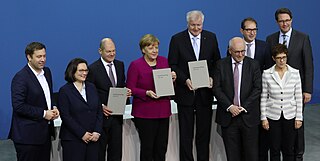 W
WThe Fourth Merkel cabinet is the 23rd and current Government of the Federal Republic of Germany, sworn in on 14 March 2018 after Angela Merkel was proposed as Chancellor by Federal President Frank-Walter Steinmeier and elected by the Bundestag on the first ballot.
 W
WThe First Cabinet Müller was the third democratically elected government of Germany and the second in office after the Weimar Constitution came into force in August 1919. It was named after the new Chancellor (Reichskanzler) Hermann Müller of the Social Democratic Party of Germany (SPD). The cabinet was based on the same three centre-left parties as the previous one: the SPD, the German Center Party (Zentrum) and the German Democratic Party (DDP). It was formed in March 1920 after the resignation of the Cabinet Bauer. The Cabinet Müller resigned in reaction to the outcome of the Reichstag elections of 6 June 1920.
 W
WHermann Müller was a German Social Democratic politician who served as the foreign minister (1919–1920), and twice as the chancellor of Germany in the Weimar Republic. In his capacity as the foreign minister, he was one of the German signatories of the Treaty of Versailles.
 W
WFranz Joseph Hermann Michael Maria von Papen, Erbsälzer zu Werl und Neuwerk was a German conservative politician, diplomat, Prussian nobleman and General Staff officer. He served as the chancellor of Germany in 1932, and then as the vice-chancellor under Adolf Hitler from 1933 to 1934.
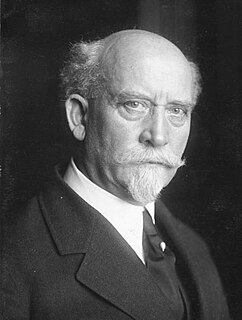 W
WThe Scheidemann cabinet was the first democratically elected Reichsregierung of the German Reich. It took office on 13 February 1919. Although the Weimar Constitution was not in force yet, it is generally counted as the first government of the Weimar Republic. It was based on the Weimar Coalition of centre-left parties. Ministerpräsident Philipp Scheidemann resigned in protest against the Treaty of Versailles on 20 June 1919. His cabinet was followed by the government of Gustav Bauer.
 W
WKurt Ferdinand Friedrich Hermann von Schleicher was a German general and the last chancellor of Germany during the Weimar Republic. A rival for power with Hitler, Schleicher was murdered by Hitler's SS during the Night of the Long Knives in 1934.
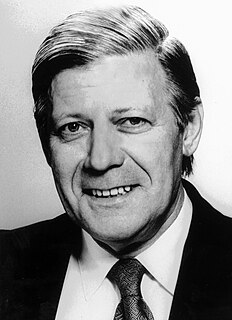 W
WThe First Schmidt cabinet was the government of Germany between 16 May 1974 and 14 December 1976, during the 7th legislature of the Bundestag. Led by the Social Democrat Helmut Schmidt, the cabinet was a coalition between the Social Democrats (SDP) and the Free Democratic Party (FDP). The Vice-Chancellor was the Free Democrat Hans-Dietrich Genscher (FDP).
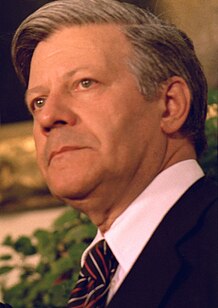 W
WThe Second Schmidt cabinet was the government of Germany between 16 December 1976 and 5 November 1980, during the 8th legislature of the Bundestag. Led by the Social Democrat Helmut Schmidt, the cabinet was a coalition between the Social Democrats (SDP) and the Free Democratic Party (FDP). The Vice-Chancellor was the Free Democrat Hans-Dietrich Genscher (FDP).
 W
WThe Third Schmidt cabinet was the government of Germany between 6 November 1980 and 1 October 1982, during the 9th legislature of the Bundestag. Led by the Social Democrat Helmut Schmidt. After the 1980 federal election, incumbent Chancellor Schmidt continued the social-liberal coalition between his SPD and the FDP.
 W
WThe First Schröder cabinet was the 19th Government of Federal Republic of Germany in office from 27 October 1998 until 22 October 2002. It succeeded the Fifth Kohl cabinet formed after the 1998 elections. Gerhard Schröder, Minister President of Lower Saxony, reached an agreement on a coalition with the Alliance 90/The Greens (Greens) and his Social Democratic Party (SPD), setting the stage for Schröder to become Chancellor of Germany. Joschka Fischer (Greens) replaced Klaus Kinkel (FDP) as Vice-Chancellor of Germany and Federal Minister of Foreign Affairs. The cabinet was succeeded by the Second Schröder cabinet.
 W
WThe Second Schröder cabinet was the 20th Government of Federal Republic of Germany in office from 22 October 2002 until 22 November 2005. It succeeded the First Schröder cabinet formed after the 2002 elections. Chancellor Gerhard Schröder, continue the coalition with the Alliance 90/The Greens (Greens) and his Social Democratic Party (SPD). Joschka Fischer (Greens) served as Vice-Chancellor of Germany and Federal Minister of Foreign Affairs. The cabinet was succeeded by the First Merkel cabinet following the 2005 elections.
 W
WThe First Stresemann cabinet was the eighth democratically elected Reichsregierung of the German Reich, during the period in which it is now usually referred to as the Weimar Republic. The cabinet was named after Reichskanzler (chancellor) Gustav Stresemann and took office on 13 August 1923 when it replaced the Cuno cabinet under Wilhelm Cuno. The cabinet resigned late on 3 October 1923 and was replaced on 6 October by another cabinet formed by Stresemann.
 W
WThe Second Stresemann cabinet was the ninth democratically elected Reichsregierung of the German Reich, during the period in which it is now usually referred to as the Weimar Republic. The cabinet was named after Reichskanzler (chancellor) Gustav Stresemann and took office on 6 October 1923 when it replaced the First Stresemann cabinet which had resigned on 3 October. Stresemann's second cabinet resigned on 23 November 1923 and was replaced on 30 November by the first cabinet under chancellor Wilhelm Marx.
 W
WThe First Wirth cabinet was the fifth democratically elected Reichsregierung of the German Reich. It was named after Reichskanzler (chancellor) Joseph Wirth and took office on 10 May 1921 when it replaced the Fehrenbach cabinet.
 W
WThe Second Wirth cabinet was the sixth democratically elected Reichsregierung of the German Reich, during the period in which it is now usually referred to as the Weimar Republic. The cabinet was named after Reichskanzler (chancellor) Joseph Wirth and took office on 26 October 1921 when it replaced the First Wirth cabinet.